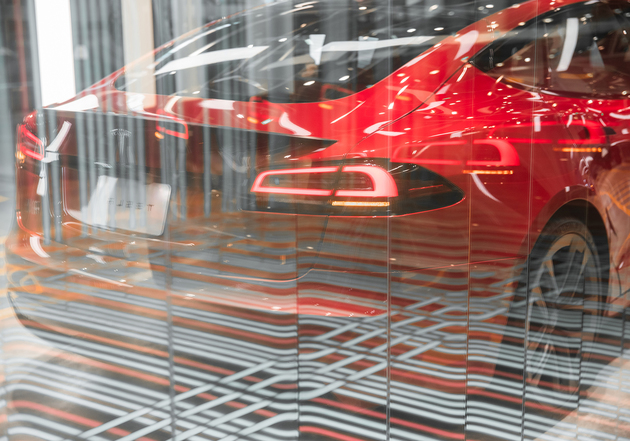
Photo/Zhang Jian (NBD)
On April 24th, Eastern Time, after the market closed, Tesla released its Q1 2024 earnings report. This quarter, not only did Tesla's sales plummet, but revenue, net profit, and gross margin also saw both year-over-year and sequential declines.
Despite the disappointing earnings, Tesla CEO Elon Musk painted a new business vision in the subsequent earnings call with analysts: the autonomous taxi service Robotaxi is set to launch this August, and the previously rumored low-cost new car is also expected to be released next year. This news triggered a capital market frenzy, resulting in Tesla’s stock price still rising by 14.44% for the week, increasing its market value by $67.7 billion, even after the “bleak” Q1 report.
Investors barely noticed during the call that at the end of the earnings report, Tesla showcased its ecosystem for the first time under the title “More Than Just Vehicles.” As traditional car manufacturing growth faces obstacles, Tesla is steadily advancing towards a strategic ecological loop of “vehicles, storage, AI,” including AI, FSD (Full Self-Driving), and energy storage, which may be driving it into its next growth phase.
The earnings report revealed that Tesla invested up to $1 billion in AI computing in the first quarter, with AI training computation increasing by over 130%. Tesla stated that the company is no longer limited by computing power and will continue to enhance its core AI infrastructure capabilities in the coming months.
During the earnings call, Musk disclosed that Tesla has successfully installed and calibrated 35,000 NVIDIA H100 GPUs and expects to deploy 85,000 NVIDIA H100 GPUs for AI training by the end of this year.
Morgan Stanley analyst Adam Jonas pointed out that Dojo has the potential to add $500 billion to Tesla’s market value, mainly driven by faster adoption rates in mobility (robot taxis) and network services (SaaS). Jonas believes that Dojo’s ability to process visual data is extremely powerful, capable of opening up “new potential markets” far beyond automobiles, applicable in fields like robotics, healthcare, and security. Essentially, any device equipped with a camera and making real-time decisions based on visual input could benefit from Dojo.
Musk once stated that 6 billion miles driven is an important milestone for a qualitative change in the FSD system. In Q1 2024, Tesla’s FSD system reached a total real-world mileage of 1.25 billion miles (approximately 2 billion kilometers). Tesla expects that at the current pace, the cumulative mileage of FSD could reach 2 billion miles by the end of May and 6 billion miles within a year.
To expand the coverage of FSD, Tesla recently reduced the monthly subscription price and package purchase price of FSD in the United States: the FSD subscription price was reduced from $199 per month to $99, a decrease of 50.25%; the FSD package purchase price was reduced by 33% from $12,000 to $8,000.
Tesla claimed in the earnings call that FSD is “just one step away” from full commercial use, and once achieved, this technology will become Tesla’s “cash cow,” bringing in substantial profits.
However, Daniel Ives, Managing Director and Senior Equity Analyst at Wedbush, stated in an email to NBD, “FSD and autonomous driving are key long-term strategies for Tesla. Although the prospects are promising, they also bring a series of regulatory and technical challenges. Tesla must gradually overcome these challenges in the coming years to realize Musk’s strategic vision.” He also mentioned that re-accelerating unit growth is Tesla’s focus for the coming year.
Besides AI, humanoid robots, and FSD, energy storage is also a key area of Tesla’s strategy.
Since 2015, Tesla has been rolling out energy storage products in the United States, mainly targeting large industrial and commercial storage and home energy storage markets. Tesla’s energy storage products, including Powerwall, Powerpack, and Megapack, are now deployed in over 65 countries and regions worldwide, with more than 1,500 operating sites.
In 2023, Tesla’s energy storage product installations reached 14.7 gigawatt-hours, a 125% increase year-over-year. The installation volume in the first quarter of this year hit a record 4.1 GWh (gigawatt-hours: 1 GWh = 1,000 megawatt-hours).
It is reported that Tesla’s Shanghai energy storage super factory will produce the large-scale commercial energy storage battery Megapack. Based on integrated system integration and modular design, this product helps grid operators and utility companies store and distribute renewable energy more efficiently. It is the largest electrochemical energy storage device in the world to date. Each Megapack unit can store over 3.9 MWh (megawatt-hours) of energy, enough to meet the electricity needs of 3,600 households for one hour. More than 200 Megapacks can form an energy storage power plant, capable of storing 1 million kilowatt-hours of electricity, meeting San Francisco’s electricity needs for 6 hours.


 川公网安备 51019002001991号
川公网安备 51019002001991号





